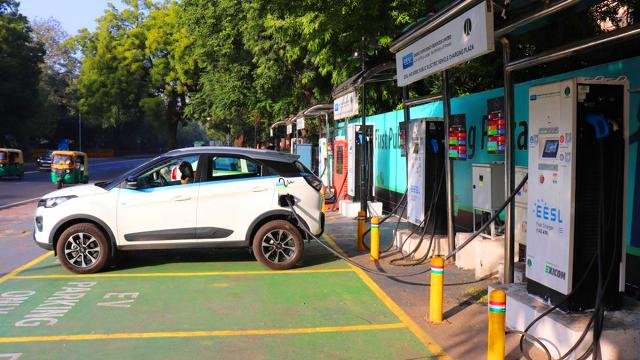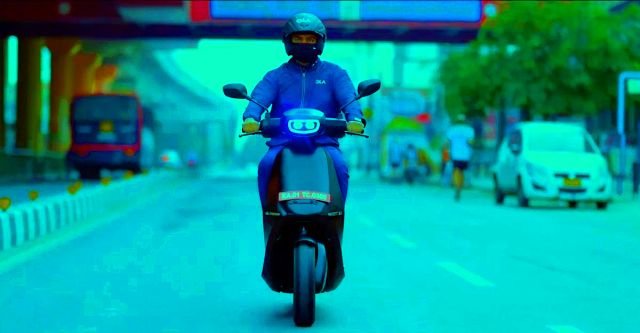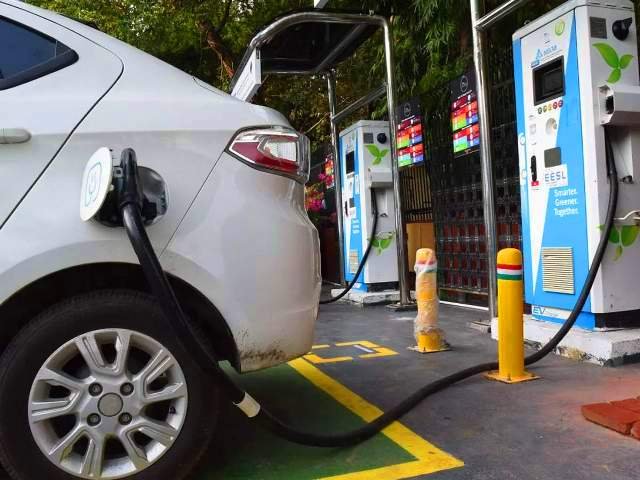Due to increasing global warming, not only India but all of the world’s top automakers have concluded that electric vehicles are the way of the future.
India has the fifth largest car market in the world, and with continuous rapid growth, it can come within the top three in the near future.
With the rapid increase in petrol and diesel fuel prices, the Indian government is religiously pushing for the introduction of Electric Vehicles (EV), which will ensure a cleaner environment and reduce India’s oil import bills in the near future.

India is among a handful of countries that support the global EV30@30campaign, which aims for at least 30 per cent of new vehicle sales to be electric by 2030. India’s advocacy of five elements for climate change “Panchamrit” at the COP26 in Glasgow is committed.
Various ideas were espoused by India at the Glasgow summit, such as renewable energy catering to 50 per cent of India’s energy needs, reducing carbon emission by 1 billion tonnes by 2030 and achieving net-zero by 2070.
In March 2022, Minister for Road Transport and Highways, Nitin Gadkari mentioned in the Parliament that between 2019-2020 and 2020-2021, the two-wheeler EVs rose by 422%; three-wheelers by 75%, and four-wheelers up by 230%. The number of electric buses also increased by over 1,200%. The push for EVs is also expected to play an important role in the local EV manufacturing industry for job creation.
Hurdels For EVs
There are many roadblocks that are giving Indian customers the creeps and preventing the widespread adoption of electric vehicles. The Indian government is continually seeking to stimulate the use of electric cars by decreasing the cost of gasoline imports and improving air quality by providing subsidies and other incentives. Although sales of these electric vehicles are increasing, there are several issues on the ground.
India buys approximately 25 million autos every year, according to certain estimates (including two-wheelers). By importing batteries, microcontrollers, motors and the ores that account for 60% of a vehicle’s cost, India will spend upwards of $65 billion per year to make transportation completely electric.

Budget-segment two-wheeler and four-wheeler passenger vehicles dominate the Indian auto industry. This rapid rise in EV demand has been linked to middle-income Indian families concerned about the “price tag” of a new car while making a purchase. The high cost of electric vehicles is one of the most significant barriers to their adoption in India.
EVs are more costly than ICEs and have a much larger initial investment. The price difference between an electric car and a comparable ICE vehicle can go up to as high as three to four times, making EVs a less appealing alternative for the ordinary Indian buyer. This significant disparity in EV upfront prices might result in expensive research and battery expenses, a shaky raw material supply chain, and inadequate economies of scale.
The EV industry is expected to develop at a robust CAGR of 43.13 percent from 2019 to 2030, according to Research and Markets’ India Electric Vehicle Ecosystem Market Outlook 2030.
According to a Grant Thornton Bharat-FICCI poll, India would need 400,000 charging stations by 2026 to meet the demand for two million electric vehicles on the road.
Charging infrastructure installation is expected to expand at a CAGR of 42.38 percent. The cost of sustaining electric vehicles on the road will be at least half that of oil if the US does not engage in electric vehicle production, which requires the specialised fabrication of multiple microcontrollers, electric motors, and telematics hardware. This big issue stems from legacy investments in the internal combustion engine, as well as the fact that the bulk of component suppliers are still stuck in the past.
The cost of a battery inside an electric vehicle now accounts for 40–50% of the vehicle’s overall production cost. Metals including lithium, cobalt, nickel, and manganese are used in the battery pack of an electric scooter, which is made up of lithium-ion cells.
The main issue with these raw resources is that they are less easily available and frequently restricted to certain geographical areas, making them more expensive. India imported $1.23 billion worth of lithium-ion batteries in 2018-2019.
To source these raw materials, India’s industry must be able to grow to mitigate the high import costs of the remainder of the battery pack, through various initiatives such as by promoting domestic lithium-ion battery cell production plants. The industry of battery energy storage is at a very nascent stage in India, but with the proposed government plans of providing $4.6 billion in incentives for setting up battery manufacturing facilities with modern technologies, battery costs could significantly fall in the coming months and years.
Economies of scale refer to cost savings received as a result of the size of an operation, i.e. the larger the operation, the greater the savings on specific fixed expenses. Currently, the majority of electric vehicle (EV) original equipment manufacturers (OEMs) do not benefit from their sales. High manufacturing and R&D expenses, raw material supply restrictions, and poor production capacity all have an impact. Costs are coming down as a result of increased expenditures in R&D and manufacturing capacity, as well as an increase in the number of EV sales, thus this promises a good chance in the industry’s economies of scale.
In the case of electric vehicles, charging infrastructure refers to the network of EV charging stations and battery swap stations that are required to refuel EVs reliably while on the road. As a result, India’s adoption of electric vehicles is hampered by a large gap and a lack of significant charging infrastructure. The first is to ensure that the system can supply enough energy to swiftly charge a large number of EVs, and the second is to ensure that the distribution system is in place to charge the correct vehicles at the right time.

Due to a lack of sufficient charging infrastructure, potential electric vehicle purchasers are experiencing “range anxiety.” The biggest problem is that the charge in an electric vehicle will not last until it reaches its destination. To ease range anxiety, we need to build a wide network of charging infrastructure, create better battery capacity – yet at a cost-effective price – and develop battery-swapping technologies that save time.
The mindset about the availability of public charging infrastructure can be vital in the adoption of EVs. Large-scale public infrastructure development can assist potential buyers to overcome range anxiety and connect urban, regional, and rural areas. The Indian government aids infrastructure development, bringing India closer to its aim of being an electric vehicle nation.
India recorded a power supply shortage of 1,201 million units in October 2021 — the highest in 5.5 years due to a crunch in coal stocks available with thermal plants. To have revolutionary switch to electric vehicles, our country needs to address the basic issue of power shortage. Lack of constant power supply in villages and smaller towns and metros like Delhi and NCR having major breakdowns for hours at a stretch. Summers is likely to affect the EV switch on a large scale, maximum EV users will be two and three wheelers and this consumer does not get power supply 24/7.
EV revolution is presently focused on metros where the consumer has range anxiety because of a daily travel of 100km, whereas the actual consumer is in tier-II and tier-III, where the travel radius is 15-20km; here a consumer can ride 150-180km after electrification without the worry of a recharge or looking for a swapping station.
However, India does not have infrastructure or technology to manufacture chips or Lithium-Ion Cells; until we have the basic infrastructure in place it is a challenging road ahead, with increase in dollar prices and volatile import situation due to rising tensions.
Currently, the EV market is fragmented with independent dealerships which make it difficult to create proper infrastructure for second-hand sales. Moreover, warranties, quality and strength of the vehicle vary significantly. Vehicles many times lose form because of rough use, or the battery degrades. At present there is hardly any formal infrastructure for sale of used vehicles. Shortage of global semiconductors further creates supply chain issues and promote localisation of commodities for automotive OEMs (Original Equipment Manufacturer).
Future Mission
India is working on the mission, but obtaining the EV nation designation would take time. Because everyone is eager for environmentally friendly and cost-effective personal transportation solutions, and because online shopping is quickly becoming the norm, the ever-present COVID-19 situation is projected to increase the rate of adoption of EVs. The popularity of electric vehicles has grown rapidly among customers, but practical adoption appears to be gradual.
The upfront costs and lack of confidence in EVs must be reduced through a combination of measures and programs implemented by a variety of stakeholders – the industry must promote domestic manufacturing of EV batteries and work with the government to ensure that this is implemented where possible, the government must step up and take responsibility for developing a nationwide charging infrastructure network, and consumer participation will be required to boost the market. Electric mobility is intended to assist India in meeting its Sustainable Development Goals (SDGs), reducing/easing traffic congestion, and decoding the complicated code of developing sustainable cities.
Over 60% of consumers believe that an EV is beyond their budget.
Hoping to convert more consumers into Electric Vehicle owners, the government is offering subsidies for purchasing electric vehicles. A tax exemption of Rs 1.5 lakh is also given for people buying electric cars on loan. The GST for the purchase of EVs is set at just 5% with zero cess.

Under two phases of the FAME or faster adoption and manufacturing of hybrid and electric vehicles scheme, the government has been trying to improve the infrastructure for electric vehicle manufacturing in the country. There is also a plan for 22,000 EV charging stations to be set up by Oil Marketing Companies across the country.
In the 2022 budget, a battery swapping policy was announced as an easier way to charge EVs. Last year, the government also announced a Production Linked Incentive scheme for automakers, a part of which aims to boost electric vehicles manufacturing.
The government introduced a slew of measures in line with ‘Make in India’ campaign to incentivise manufacturers to produce components locally and build a structured policy framework as India is heavily dependent on China for lithium supply chains constraining the widespread deployment of EVs. Recent policies that were introduced, including battery swapping policy, aimed at an encouraging move towards green energy generation and decentralisation of energy distribution is likely to create a well-established EV infrastructure across the country, while instilling customer confidence in riding EVs on Indian roads. The battery swapping model for supplying power has side-stepped the lack of charging infrastructure but the future is likely to see a mix of both models.
However, large OEMs are making initiative to venture into EV components market to reduce reliance on imports and meet the 50% localisation criteria to access government subsidies.
A substantial infrastructure that is affordable, accessible and serves all consumer groups coupled with strong financing ecosystem, policy incentives, and technological advancements is likely to poise the EV market for significant growth in the coming decade.
The Ministry of Power has prescribed at least one charging station to be present in a grid of 3 km and at every 25 kms on both sides of the highways.
India’s Ministry of Housing and Urban Affairs, under the Model Building Bye-laws, 2016 (MBBL), has mandated setting aside 20 per cent of the parking space for EV charging facilities in residential and commercial buildings and such an example is worth emulating by developing economies.
Until EVs become affordable, the Indian government has stepped in with a host of incentives under the umbrella FAME 2 Scheme. The level of incentives now on offer for EVs in India are the highest ever — up to Rs 32,000 for electric two-wheelers, Rs 3 lakh for electric cars and Rs 35-55 lakh for buses. There is an additional income tax rebate on loans taken for buying electric cars.

As per a study by the CEEW Centre for Energy Finance (CEEW-CEF), the market opportunity is worth nearly USD 206 billion (Rs 14,42,000 crore), with cumulative EV sales in all vehicle segments projected to jump to over 100 million units by FY30. It has been estimated that over USD 180 billion (Rs 12,50,000 crore) investment will be required in vehicle production and charging infrastructure until 2030, and this presents a huge opportunity for foreign investors.
Battery Technologies
Aluminium-ion Batteries
Lithium-ion batteries are being used in EVs for a long time. Drawbacks of li-ion batteries made alternative research on chemicals to maximize the efficiency of batteries. Aluminium-ion batteries are good for energy storage, which is for their gravimetric and volumetric capacities. Aluminium is more abundant than lithium. Al-ion batteries provide four times more energy than Li-ion batteries at a low cost.
Foldable Batteries
The foldable battery is Jenax’s innovation. It is a lithium-ion battery that can be folded over 200,000 times without compromising performance. These batteries support fast charging and can be used to power up small components in EVs. It is stable even with bending fatigue and has a high energy density. Foldable batteries have an operating temperature from -20C to 60C which makes them suitable for any climatic condition.
Lithium-Air Battery
The lithium-air battery (LiO2B) is yet another lithium battery that needs to be explored more due to its high capability in producing energy. In the cell, the anode is lithium metal, the cathode is porous carbon and the electrolyte used is non-aqueous. It can theoretically produce a high specific density of 3505 Wh/kg.

Lithium-Sulfur Battery
Sulfur is an element that is abundantly present in nature and inexpensive. It is environmentally friendly so lithium-sulfur batteries are not toxic to the environment. Lithium metal is used as the anode and sulfur composite as cathode while the electrode being an organic liquid. Sulfur has a theoretical capacity of 1675 mAh/g while lithium metal has a theoretical capacity of 3860 mAh/g. Lithium-sulfur battery has a specific energy of 2567 Wh/kg.

